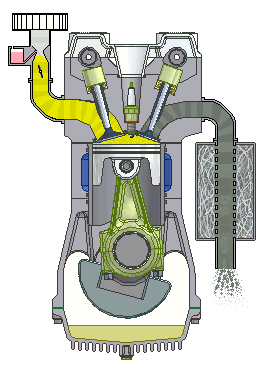Turning it up to 11--The Two-Stroke Experience: Part 1-What’s a Two-Stroke?
Toronto, Ontario, Canada
“Hey buddy,” shouts the head gawking out of the aging Corolla that’s just pulled along side as I wait for a red light to turn green. “Ya know, your bike is smoking a lot!"
His perception of the obvious is nothing short of miraculous; and I want to rant. I want to explain how a two-stroke engine works—how, at idle, the volume of the fresh fuel/air concoction coming in from the transfer ports is much smaller than the volume of exhaust left in the cylinders from the last power stroke, causing misfires and some unburnt hydrocarbons blowing out through the pipes.
Ah, but I am out for a ride; not to pontificate on the inner workings of motorcycle engines. Water off a duck's back. “Uh, thanks,” I say with a smirk and a wave. My inner geek will have to wait for another day.
Like today.
So it is, fellow riders, that I find myself standing atop this homemade, plywood box workbench ready to spread the Gospel of The Eternal Stink Wheels to those of you curious about these eccentric beasts and willing to indulge my manic ramblings. Let us begin with some basics.
What Exactly is a Two-Stroke, Anyway?
The term, “two stroke” refers to the engine design. Engines of this breed generate a power stroke every time the piston makes two strokes (one up; one down).

1
Compare this with the four stroke engines most of us are familiar with, that make a power stroke every four strokes (up-down-up-down).

2
This translates into more power per cc than a four-stroke (alas, not twice as much; 150% - 170% is typical).
To experience this for yourself, go for a bicycle ride using just one foot: Each time the pedal is at the top, you push down on it; then, when the pedal reaches the bottom, you wait for it to come back up before pushing down on it again. No revelation, here; you’re simply riding a bicycle using only one foot. However, you’ve just copied what a two-stroke engine does.
Now, try doing this again; only, this time, wait for the pedal to make a second, 360-degree rotation on its own before you push down a second time: Push the pedal down; wait for it to come back up; wait for it to go back down a second time on its own; and, finally, wait for it to come back up again before pushing down again. Now try doing this up a steep hill. Eh? Eh? Right? That’s a four-stroke.
What's (cough) with all (cough-cough) the Smoke?
If two strokes are affectionately referred to as stink wheels, it's because of their signature blue exhaust --particularly when idling.
2-Stroke Smoke!
Why all the smoke? Pistons firing twice as much also produce more heat. To keep from melting down, two-stroke engines combine oil with the air/fuel mixture in the cylinders--either by pre-mixing oil with the gasoline in the fuel tank; or through other, more ingenious methods--my T500, for example has a series of tubes that inject oil directly into the cylinder from an oil tank based on how wide the throttle is open.
Now, if you were designing an engine in which you needed to add oil to hot cylinders, what do you think would would be the easiest way to dispose of that oil after it's done it's job of keeping pistons from fusing with cylinder walls? That's right! Burn it and shoot it out the back with the exhaust! Hence the smoke (which--surprise, surprise--was a key factor in the ultimate demise of two-stroke street bikes).
In fact, when tuned and running at speed, the smoke emanating from a two-stroke is negligible because the transfer ports that replace the cylinder's exhaust with a fresh mixture of fuel and air (and oil) are working optimally.
At idle, though, they're not; and it's at these times they tend to produce blue clouds out the back—which leads to rubber-neckers sticking their heads out of their car windows and commenting on the obvious.
Next time: Add To Bucket List: Ride An Early 70s Two-Stroke
Image Credits:
1 - By derivative work: Turbojet (talk) Arbeitsweise_Zweitakt.gif: Topory, A7N8X (Arbeitsweise_Zweitakt.gif) [GFDL (http://www.gnu.org/copyleft/fdl.html) or CC-BY-SA-3.0 (http://creativecommons.org/licenses/by-sa/3.0/)], via Wikimedia Commons
2- By 4-Stroke-Engine.gif: UtzOnBike (3D-model & animation: Autodesk Inventor) derivative work: Cuddlyable3 at en.wikipedia (4-Stroke-Engine.gif) [GFDL (http://www.gnu.org/copyleft/fdl.html) or CC-BY-SA-3.0 (http://creativecommons.org/licenses/by-sa/3.0/)], via Wikimedia Commons
You must be logged in to comment
Login now